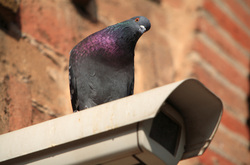 by Alex A. Kecskes Today, more architects than ever are integrating pigeon control measures into their building designs. They know that the image of beautiful arches, clean lines and walls of glass can quickly be ruined by bird droppings. They also know that the acid in bird droppings can eat into wood, composites and even stone surfaces to permanently damage areas that were once showpieces of design. The fact is, many clients ask for references when contracting architects. The references are often in the form of completed projects. If these artistic creations are covered in bird droppings and their surfaces eaten away, they become useless as samples of one’s work—often to the point of excluding an architect from future bids. So the importance of effective pigeon control—or any bird control—for that matter, can’t be understated. Adding pigeon control and bird control services is an excellent way to round out an architectural firm’s repertoire of capabilities. The goal is to install effective pigeon control measures during the design-build process and to use low-profile humane deterrents that are easy to install and maintain. Keeping pigeons and other pest birds away from commercial, civil or large federal structures can be an added profit center for any architectural firm. When integrating pigeon control measures into an architectural design, one must take into account the aesthetics. Building materials and surfaces should be analyzed to ensure that the bird control methods minimally impact the overall structure. When enlisting the services of a bird control firm, that firm should offer products that are easy-to-specify. Any bird control repellents and/or deterrents used should meet the approval of local, state and federal agencies for humane operation. The products specified should be of the highest quality and be easy to “drop in” to projects specs. They should be backed by extensive warranties and the firm should offer support to help with the bird control designs.
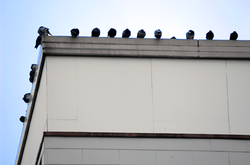 by Fran Prisco Pigeons that are a pest in our cities and suburbs across the Nation are ancestors of the Rock Dove. Rock Doves built their nests high on rock cliffs, very similar to our city buildings of today. Pigeon nests are made up of loose twigs and other material that is found nearby. Along with nesting material, pigeons also leave behind a mess with their droppings and molted feathers. Each year building owners spend thousands to get rid of pigeons from their buildings. Clean up FirstBefore installing any type of bird control system, it is important to do a thorough cleanup. It is best to power wash or spray bird droppings down and remove them while wet. Dried bird droppings can cause dust which when breathed in may carry any of 60 plus communicable diseases. Bird Droppings are also acidic and can quickly erode building and roofing materials, not to mention that they are a safety hazard on sidewalks, causing slip and fall accidents.
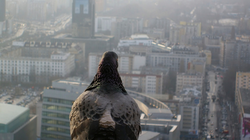 By Alex A. Kecskes One of the many concerns facing today’s property managers is pigeon control. Pigeons are pest birds that remain unprotected by the Migratory Bird Treaty Act of 1918. They can cause property managers a lot of grief. So what attracts pest pigeons to a commercial building, its edifices and rooftops? A combination of factors. First off, commercial buildings usually offer covered areas that provide shelter from the elements. Things like rooftop AC units, electrical boxes, and ducting offer ideal places to nest and roost. Ledges and parapet walls offer high altitude perches for scouting predators and prey, especially if they overlook trash bins and dipsy-dumpsters. Also, if your commercial building is the only one in the area offering such vantage points, it will attract flocks of pest pigeons. Another attractive feature of your building may be that it lies close to ponds, fields, and electrical wires. And if you’re unlucky enough to have a flock of pigeons already nesting on your building, the droppings will attract other pigeons, making your building a prime gathering spot. In general, pigeons will be strongly attracted to nesting spots they have already claimed as their own. Without effective pigeon control measures, a pest pigeon infestation can result in costly and repetitive clean-ups. Long-term infestations. Can severely damage a commercial building’s facades, sills, parapet walls, roofing, water drainage systems and rooftop AC units. The annual damage/repair/cleanup cost of pest birds to commercial buildings is estimated to be in the hundreds of millions of dollars.
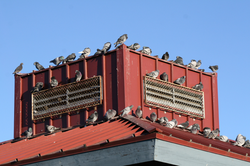 By Alex A. Kecskes If you own a commercial building, you no doubt have had problems with pigeons. In most cases, the larger the building, the bigger the problem. For strip malls, commercial centers, warehouses and other large structures, pigeons can cause all sorts of headaches for property managers and property owners. If your building has a flat roof, pigeon debris, feathers and droppings can damage AC units, ventilators and drainage areas. Pigeons love to gather around rooftop equipment, and as you know, AC units are not cheap. They cost plenty to maintain and repair. Without proper pigeon control, pigeon debris can stop up rain vents and gutters, causing flooding. Hundreds or even thousands of gallons of water trapped on a long flat roof can lead to structural problems and ultimately roof collapse. Once this occurs, you have a huge problem in terms of damage to inventory inside a building. Whether your building is covered by a roof made of wood shingles or tiles, pigeons waste can be highly destructive. The acidic content of pigeon droppings can eat into the sub-roofing materials and eventually cause leaks. Bird droppings can also deface and damage your expensive signage—whether your signs are fabricated of metal, wood or plastic. Pigeons can also create an image problem. Bird droppings on entryways, walkways, display windows, benches, umbrellas and nearby lampposts can be a real turn off (and costly daily cleanups for you).
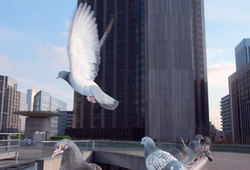 By Arlene Connelly Many urban dwellers are unaware that more than 60 human diseases — including avian flu, salmonella, E coli and West Nile virus — are related to pigeons, other pest birds and their droppings. Besides being a public health issue in many cities, they often create a safety hazard for pedestrians, and they carry dangerous parasites and harmful bacteria. Some of these illnesses can even be fatal to humans; they can be contracted through contact with the skin and exposure through inhalation as people go about their daily activities. Why pest pigeons are especially dangerousPigeons are generally considered to be “the number one bird pest” in America today, their numbers are increasing, and their nesting instincts are strong. They usually mate for life, live in communal flocks that travel together, and tend to roost where they can find adequate food and shelter. Along with that, experts in the field now consider pigeons to be a genuine “urban menace,” threatening the quality of life in America’s great cities, including San Francisco, Chicago and New York. Pigeon droppings can be found on walkways, roofs, window ledges and the sides of some of our finest buildings— anyplace these birds can access. This is especially dangerous around air vents and areas that surround water sources; the germs they carry can easily be transmitted to humans, especially those with a weakened immune system. They also attract insects that can spread disease as well, creating serious liability issues for businesses and restaurateurs. The corrosive affect of pest pigeon droppings results in extensive and expensive damage to our public buildings and monuments, and they can cause a serious disaster like the collapse of the Minnesota Bridge. Feathers, droppings and nest paraphernalia can also be sucked into pipes and vents, creating a fire hazard in a city’s high-rise buildings where people work and live.
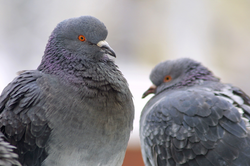 by Alex A. Kecskes The ubiquitous pigeon has been man's friend and foe for centuries. Rising to nuisance level as they invaded our cities and towns, pest pigeons cause over one billion dollars annually in damage and cleanup costs. It's not surprising. Pigeon poop alone can cause all sorts of damage. It can eat into wood and metal, ruin fine stonework, and seize up AC units. Worse yet, pigeon poop is teaming with bacteria, fungi and parasites, which is why it poses such a high health risk. After all, pigeon droppings have been known to carry any of 60 known diseases. And no less hazardous are the fleas, mites and ticks that infest pigeons. It's no wonder that pigeon control has become so important. Thankfully, there are a number of highly effective pigeon control methods on the market.. One can't talk about pigeon control without mentioning the various Bird Scare products currently available. These flash tape banners wave, flap and crackle in the breeze to frighten pigeons looking for a safe place to land and roost. The same holds true for the inflatable, Bird Scare Balloon. Imprinted with menacing looking predator eyes, these devices turn and flail in the breeze to frighten pest pigeons away.
|






 RSS Feed
RSS Feed